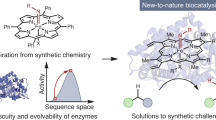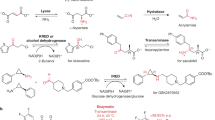Abstract
THE development of biochemistry, during the last two decades, has largely increased the number of known components of organisms, and beyond discovering them and surveying their distribution, biochemistry was able to assign to many formerly known and newly discovered substances their part in the structure of living matter, their part in the chemical reactions occurring in cells and tissues, and in the regulation of the functions of the organs. The large increase of our materia biochemica was proceeding simultaneously with the elucidation of the mechanisms of biochemical reactions, which appear, now, quite different from what could be imagined twenty years ago ; not only in the complexity of the intermediary transformations leading to the final products, but especially as concerns the nature and the numbers of reagents—of the organism's own reagents, of course—taking part in them.
This is a preview of subscription content, access via your institution
Access options
Subscribe to this journal
Receive 51 print issues and online access
$199.00 per year
only $3.90 per issue
Buy this article
- Purchase on SpringerLink
- Instant access to full article PDF
Prices may be subject to local taxes which are calculated during checkout
Similar content being viewed by others
References
For a more comprehensive review, see Parnas, J. K., Glykogenolyse, Hdb. d. Enzymologie (Nord u. Weidenhagen, 2, 902–967, Leipzig 1940, or Ouspechi Sovrem. Biologii, U.S.S.R., 12, 393, 1940), also the article by W. Franke in the same volume. Also: D. E. Green, "The Mechanisms of Biological Oxidations", London, 1941.
Synonymous with what is called by different authors co-enzyme I and co-enzyme II, or codehydrase I and codehydrase II, or pyridine or pyridine-nucleotide. Cozymase was discovered by Harden and Young, given this name, and investigated, under the same, in numerous papers by von Euler and Myrbäck. There is no reason for giving a substance a new trivial name after the isolation and elucidation of its structure. Phospho-cozymase is a logical extension of the name cozymase for its derivative containing one phosphate group more.
Author information
Authors and Affiliations
Rights and permissions
About this article
Cite this article
PARNAS, J. CO-ENZYMATIC REACTIONS. Nature 151, 577–580 (1943). https://doi.org/10.1038/151577a0
Issue date:
DOI: https://doi.org/10.1038/151577a0



